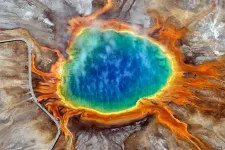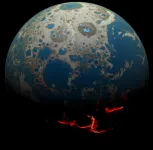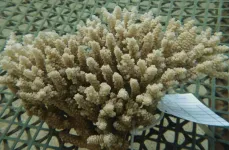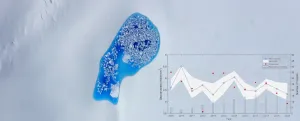(Press-News.org) MUNICH -- Rewilding--a hands-off approach to restoring and protecting biodiversity--is increasingly employed across the globe to combat the environmental footprint of rapid urbanization and intensive farming. The recent reintroduction of grey wolves in Yellowstone, America's first national park, is regarded as one of the most successful rewilding efforts, having reinvigorated an ecosystem that had been destabilized by the removal of large predators.
However, successful attempts to rewild the landscape hinge on more than just the reintroduction of a plant or animal species, they also require that geography and geology be taken into account, according to new research from the University of Amsterdam and the Dutch State Forestry Service.
It is the landscape that ultimately decides the outcome of rewilding efforts, says Kenneth Rijsdijk, an ecologist at the University of Amsterdam, who is presenting the team's results at the European Geosciences Union (EGU) General Assembly 2021.
One of the key challenges of rewilding is deciding where to do it, Rijsdijk says, especially given competing land-uses like infrastructure and agriculture. "Clearly, we cannot, and should not, rewild everywhere. It makes sense to pick out specific areas where rewilding is more likely to succeed, taking into account how landscape features, like ruggedness and soil nutrients, can shape ecosystems."
Ecologists gauge rewilding success using biodiversity metrics, such as an increase in the abundance and diversity of plant or bird species. But these measurements do not factor in the role of landscape: from the topography and river systems to the soil and underlying geology.
These aspects--known collectively as geodiversity--furnish all the physical support required for life on Earth. "Landscape plays a pivotal role in defining the ecosystem: determining where vegetation grows, herbivores graze, animals seek shelter, and predators hunt," Rijsdijk says.
"It's remarkable that, from a conservation standpoint, the landscape itself is significantly undervalued in the success of rewilding projects," says coauthor Harry Seijmonsbergen, an ecologist at the University of Amsterdam.
The team aims to build a more holistic index for measuring and predicting rewilding success.
Early applications of their approach--in northwestern Europe, at sites previously marked by the Dutch State Forestry Service as possible candidates for rewilding--show that more varied landscapes show greater conservation potential.
Their index draws on more than a century of geological and geographical map data, which the team have mapped out across 12 sites in northwestern Europe--combining landscape features such as elevation, forested areas, openness, and quietness in order to compute a metric for landscape quality. They also studied how geodiversity influenced rewilding over time using satellite, aerial, and field data. By tuning their new index against a previously used ecological index, they were able to independently assess the relationship between biodiversity and landscape at each site.
As an independent test of landscape ruggedness, they supplemented their workflow with previously collected data from Yellowstone. The park's mountainous and varied terrain hosts niche environments for animals to hunt and shelter.
The new research could help decision-makers select future rewilding sites with the right recipe for success. "Conservation biologists have been asking how they can pinpoint sites with the right characteristics for rewilding," Rijsdijk says. "Our research is the first to start building the required toolkit to measure landscape quality and inform that choice."
INFORMATION:
MUNICH -- The first emergence and persistence of continental crust on Earth during the Archaean (4 billion to 2.5 billion years ago) has important implications for plate tectonics, ocean chemistry, and biological evolution, and it happened about half a billion years earlier than previously thought, according to new research being presented at the EGU General Assembly 2021.
Once land becomes established through dynamic processes like plate tectonics, it begins to weather and add crucial minerals and nutrients to the ocean. A record of these nutrients is preserved in the ancient rock record. Previous research used strontium isotopes in marine carbonates, but these rocks are usually scarce ...
Researchers have successfully grown cells from the stony coral, Acropora tenuis, in petri dishes
The cell lines were created by separating out cells from coral larvae, which then developed into eight distinct cell types
Seven out of eight cell types were stable and could grow indefinitely, remaining viable even after freezing
Some of the cell types represented endoderm-like cells, and could therefore shed light on how coral interacts with photosynthesizing algae and how bleaching occurs
The cell lines could be used in many avenues ...
Researchers have developed the first LiDAR-based augmented reality head-up display for use in vehicles. Tests on a prototype version of the technology suggest that it could improve road safety by 'seeing through' objects to alert of potential hazards without distracting the driver.
The technology, developed by researchers from the University of Cambridge, the University of Oxford and University College London (UCL), is based on LiDAR (light detection and ranging), and uses LiDAR data to create ultra high-definition holographic representations of road objects which are beamed directly to the driver's eyes, instead of 2D windscreen projections used in most head-up displays.
While the technology has not yet been ...
Patients receiving an implantable cardioverter defibrillator (ICD) should be regularly screened for anxiety and depression, according to research presented at EHRA 2021, an online scientific congress of the European Society of Cardiology (ESC).1
Study author Professor Susanne Pedersen of Odense University Hospital, Denmark said: "Most patients adapt well to living with an ICD. For others it completely changes their life, with worries about shocks from the device, body image, and livelihood as some need to change their job."
Previous studies have shown ...
Management and outcomes of adults with atrial fibrillation are presented today at EHRA 2021, an online scientific congress of the European Society of Cardiology (ESC).1 The document is published in EP Europace,2 a journal of the ESC.
Atrial fibrillation is the most common heart rhythm disorder, affecting more than 40 million people globally.3 Those with the disorder have increased risks of complications including stroke, heart failure and dementia, and are twice as likely to be admitted to hospital as their peers without the condition. The economic burden of atrial fibrillation is rising, mainly due to complications and hospitalisations.4 Effective therapies ...
Sophia Antipolis - 24 April 2021: Atrial fibrillation can be detected during annual foot assessments in patients with diabetes, according to research presented today at EHRA 2021, an online scientific congress of the European Society of Cardiology (ESC).1
"In our study, one in six patients with diabetes had previously undiagnosed atrial fibrillation," said study author Dr. Ilias Kanellos of the European University of Cyprus, Nicosia. "This presents an opportunity to provide treatment to prevent subsequent strokes."
Diabetes is an independent risk factor for atrial fibrillation.2 Prevalence of the heart rhythm disorder is at least two-fold higher in patients with diabetes compared to those ...
Lung cancer is a major global cause of mortality, reportedly accounting for 1.7 million deaths each year. The most common form of lung cancer is non-small-cell lung cancer (NSCLC), and early-stage NSCLCs can often be surgically resected. Unfortunately, some patients still experience poor outcomes after surgical resection, prompting further research on the relationship between a patient's preoperative status and the likelihood of good postoperative outcomes.
Given this need for information, Dr. Shinya Tanaka from the Department of Rehabilitation and Prof. Naoki Ozeki from the ...
As an indicator and "amplifier" of global climate change, the Arctic's health and stability is the cornerstone of the stability of our climate system. It has far-reaching impacts on ecosystems, coastal resilience, and human settlements in the middle and high latitudes.
The Arctic has experienced amplified warming and extensive sea-ice retreat in recent decades. On 15 September 2020, the Arctic sea-ice extent (SIE) reached its annual minimum, which, based on data from the National Snow and Ice Data Center, was about 3.74 million km2 (1.44 million square miles). This value was about 40% less than the climate average (~6.27 million km2) during 1980-2010. It was ...
Anastasia Malashina, a doctoral student at HSE University, has proposed a new method to assess vulnerabilities in encryption systems, which is based on a brute-force search of possible options of symbol deciphering. The algorithm was also implemented in a programme, which can be used to find vulnerabilities in ciphers. The results of the study were published in a paper 'Software development for the study of natural language characteristics'.
Most of online messages are sent in encrypted form since open communication channels are not protected from data interception. Messengers, cloud services, banking systems--all of these ...
A breakthrough astrophysics code, named Octo-Tiger, simulates the evolution of self-gravitating and rotating systems of arbitrary geometry using adaptive mesh refinement and a new method to parallelize the code to achieve superior speeds.
This new code to model stellar collisions is more expeditious than the established code used for numerical simulations. The research came from a unique collaboration between experimental computer scientists and astrophysicists in the Louisiana State University Department of Physics & Astronomy, the LSU Center for Computation & Technology, Indiana University Kokomo and Macquarie University, Australia, culminating in over of a year of benchmark testing and scientific simulations, supported by multiple NSF grants, ...



